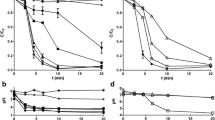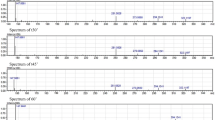Abstract
Lomefloxacin (LOM) is a synthetic antimicrobial from the fluoroquinolone family (FQ) used as a veterinary and human drug. Once in the environment, LOM may pose a risk to aquatic and terrestrial microorganisms due to its antimicrobial activity. This study evaluated the effect of ozonation of LOM (500 μg L−1), the residual antimicrobial activity against Escherichia coli and acute toxicity against Vibrio fischeri. In addition, degradation products were investigated by UHPLC-MS/MS and proposed. Ozonation was carried out varying the applied ozone dose from 0 to 54.0 mg L−1 O3 and pH values of 3, 7, and 11. Ozonation was most efficient at pH 11 and led to 92.8% abatement of LOM in a 9-min reaction time (54.0 mg L−1 O3 applied ozone dose). Ozonation at pH 3 was able to degrade 80.4% of LOM. At pH 7, 74.3% of LOM was degraded. Although the LOM concentration and the antimicrobial activity of the solution dropped as ozone dose increased (antimicrobial activity reduction of 95% at pH 11), toxicity to V. fischeri increased for pH 7 and 11 (i.e., 65% at pH 7 and 75% at pH 11). The reduction in antimicrobial activity may be related to the oxidation of piperazinyl and the quinolone moiety. The formation of intermediates depended on the oxidant (hydroxyl radicals or/and molecular O3) that acted the most in the process.




Similar content being viewed by others
References
Adachi F, Yamamoto A, Takakura K, Kawahara R (2013) Occurrence of fluoroquinolones and fluoroquinolone-resistance genes in the aquatic environment. Sci Total Environ 444:508–514
Al-Abdullah, ES (2012) Gatifloxacin. In: Harry, G.B. (ed) Profiles of Drug Substances, Excipients and Related Methodology. Academic Press, pp 183–243.
Albini A, Monti S (2003) Photophysics and photochemistry of fluoroquinolones. Chem Soc Rev 32:238–250
Almeida E, Assalin MR, Rosa MA, Durán N (2004) Wastewater treatment by oxidation with ozone. Quim Nov. 27:818–824
Caianelo M, Rodrigues-Silva C, Maniero MG, Guimarães JR (2016) Antimicrobial activity against Gram-positive and Gram-negative bacteria during gatifloxacin degradation by hydroxyl radicals. Environ Sci Pollut Res in press
Calamari D, Da Gasso R, Galassi S, Provini A, Vighi M (1980) Biodegradation and toxicity of selected amines on aquatic organisms. Chemosphere 9:753–762
Carballa M, Omil F, Lema JM, Llompart M, Garcia C, Rodriguez I, Gomez M, Ternes T (2005) Behaviour of pharmaceuticals and personal care products in a sewage treatment plant of Northwest Spain. Water Sci Technol 52:29–35
CETESB – Companhia Ambiental do Estado de São Paulo (2001) Vibrio fischeri: assay method – L5.227, São Paulo
Chemspider (2015) http://www.chemspider.com/Chemical-Structure.3811.html?rid=1c83630d-a724-4703-ace6-664a874dd235, accessed on November 1st, 2016.
Da Silva CR, Maniero MG, Rath S, Guimarães JR (2011) Antibacterial activity inhibition after the degradation of flumequine by UV/H2O2. J Adv Oxid Technol 14(1):106–114
De Bel E, Dewulf J, de Witte B, Van Langenhove H, Janssenet C (2009) Influence of pH on the sonolysis of ciprofloxacin: biodegradability, ecotoxicity and antibiotic activity of its degradation products. Chemosphere 77:291–295
De Oliveira AMD, Maniero MG, Guimarães JR (2015) Lomefloxacin degradation: antimicrobial activity, toxicity and byproducts. J Adv Oxid Technol 18:211–220
De Witte B, Dewulf J, Demeestere K, Van De Vyvere V, De Wispelaere P, Van Langenhove H (2008) Ozonation of ciprofloxacin in water: HRMS identification of reaction products and pathways. Environ Sci Technol 42:4889–4895
De Witte B, Dewulf J, Demeestere K, Van Langenhove H (2009a) Ozonation and advanced oxidation by the peroxone process of ciprofloxacin in water. J Hazard Mater 161:701–708
De Witte B, Van Langenhove H, Hemelsoet K, Demeestere K, Wispelaere PD, Van Speybroeck V, Dewulf J (2009b) Levofloxacin ozonation in water: rate determining process parameters and reaction pathway elucidation. Chemosphere 76:683–689
Dodd MC, Buffle MO, Von Gunten U (2006) Oxidation of antibacterial molecules by aqueous ozone: moiety-specific reaction kinetics and application to ozone-based wastewater treatment. Environ Sci Technol 40:1969–1977
Dodd MC, Kohler HP, von Gunten U (2009) Oxidation of antibacterial compounds by ozone and hydroxyl radical: elimination of biological activity during aqueous ozonation processes. Environ Sci Technol 43:2498–2504
Doretto KM, Peruchi LM, Rath S (2014) Sorption and desorption of sulfadimethoxine, sulfaquinoxaline and sulfamethazine antimicrobials in Brazilian soils. Sci Total Environ 476–477:406–414
Eaton AD, Clesceri LS, Greenberg AE (2005) Standard Methods for the Examination of Water and Wastewater, 21st ed., American Public Health Association
ECDC (2014) - European Centre for Disease Prevention and Control—Antimicrobial resistance interactive database (EARS-Net). http://www.ecdc.europa.eu/en/healthtopics/antimicrobial_resistance/database/Pages/database.aspx. Accessed 25 August 2014.
Fick J, Soderstrom H, Lindberg RH, Phan C, Tysklind M, Larsson DG (2009) Contamination of surface, ground, and drinking water from pharmaceutical production. Environ Toxicol Chem 28:2522–2527
Gao L, Shi Y, Li W, Niu H, Liu J, Cai Y (2012) Occurrence of antibiotics in eight sewage treatment plants in Beijing, China. Chemosphere 86:665–671
Guerra P, Kim M, Shah A, Alaee M, Smyth SA (2014) Occurrence and fate of antibiotic, analgesic/anti-inflammatory, and antifungal compounds in five wastewater treatment processes. Sci Total Environ 473-474:235–243
Hamdi El Najjar N, Touffet A, Deborde M, Journel R, Leitner NK (2013) Levofloxacin oxidation by ozone and hydroxyl radicals: kinetic study, transformation products and toxicity. Chemosphere 93:604–611
Hoigné J, Bader H (1983) Rate constants of reactions of ozone with organic and inorganic compounds in water-I. Water Res 17:173–183
Huang CP, Dong C, Tang Z (1993) Advanced chemical oxidation: its present role and potential future in hazardous waste treatment. Waste Managem 13:361–377
Jiao S, Zheng S, Yin D, Wang L, Chen L (2008) Aqueous photolysis of tetracycline and toxicity of photolytic products to luminescent bacteria. Chemosphere 73:377–382
Kummerer K (2009) Antibiotics in the aquatic environment—a review—part I. Chemosphere 75:417–434
Langlais B, Reckhow DA, Brink D.R. (1991) Ozone in water treatment: application and engenering; Lewis Publishers Inc.
Liu C, Nanaboina V, Korshin GV, Jiang W (2012) Spectroscopic study of degradation products of ciprofloxacin, norfloxacin and lomefloxacin formed in ozonated wastewater. Water Res 46:5235–5464
Muñoz F, von Sonntag C (2000) The reactions of ozone with tertiary amines including the complexing agents nitrilotriacetic acid (NTA) and ethylenediaminetetraacetic acid (EDT) in aqueous solution. J Chem Soc Perk 2:2029–2033
Peres MS, Maniero MG, Guimaraes JR (2015) Photocatalytic degradation of ofloxacin and evaluation of the residual antimicrobial activity. Photochem Photobiol Sci 14:556–562
Pollice A, Laera G, Cassano D, Diomede S, Pinto A, Lopez A, Mascolo G (2012) Removal of nalidixic acid and its degradation products by an integrated MBR-ozonation system. J Hazard Mater 203-204:46–52
Rizzuti I, Augugu LV, Marrucci G (1976) Ozone absorption in alkaline solutions. Chem Eng Sci 31:877–880
Rodrigues-Silva C, Maniero MG, Peres MS, Guimarães JR (2014) Occurrence and degradation of quinolones by advanced oxidation processes. Quim Nov. 37:868–885
Rodrigues-Silva C, Maniero MG, Rath S, Guimarães JR (2013a) Degradation of flumequine by photocatalysis and evaluation of antimicrobial activity. J Chem Eng 224:346–352
Rodrigues-Silva C, Maniero MG, Rath S, Guimarães JR (2013b) Degradation of flumequine by the Fenton and photo-Fenton processes: evaluation of residual antimicrobial activity. Sci Total Environ 445-446:337–346
Scholar E (2007) Lomefloxacin. In: Enna SJ, Bylund DB (eds) xPharm: the comprehensive pharmacology reference. Elsevier, New York, pp 1–5
Senta I, Terzic S, Ahel M (2013) Occurrence and fate of dissolved and particulate antimicrobials in municipal wastewater treatment. Water Res 47:705–714
Shao B, Chen D, Zhang J, Wu Y, Sun C (2009) Determination of 76 pharmaceutical drugs by liquid chromatography-tandem mass spectrometry in slaughterhouse wastewater. J Chromatogr A 1216:8312–8318
Shen LL, Baranowski J, Pernet AG (1989) Mechanism of inhibition of DNA gyrase by quinolone antibacterials: specificity and cooperativity of drug binding to DNA. Biochemistry 28:3879–3885
Urbano VR, Maniero MG, Pérez-Moya M, Guimarães JR (2016) Influence of pH and ozone dose on sulfaquinoxaline ozonation. J Environ Manag. doi:10.1016/j.jenvman.2016.08.019
Van Doorslaer X, Dewulf J, Van Langenhove H, Demeestere K (2014) Fluoroquinolone antibiotics: an emerging class of environmental micropollutants. Sci Total Environ 500-501:250–269
Van Leeuwen JH (2015) Proposed OS&E requirement: measuring ozone dosage. Ozone Sci Eng 37:191–192
Vieno N, Tuhkanen T, Kronberg L (2007) Elimination of pharmaceuticals in sewage treatment plants in Finland. Water Res 41(5):1001–1012
Von Gunten U (2003) Ozonation of drinking water: part I. Oxidation kinetics and product formation. Water Res 37:1443–1467
Von Sonntag C, von Gunten U (2012) Chemistry of ozone in water and wastewater treatment: from basic principles to applications. IWA Publishing, London
WHO - World Health Organization (1998) Use of Quinolones in Food Animals and Potential Impact on Human Health: Report of a WHO Meeting, Switzerland.
Acknowledgements
The authors gratefully acknowledge the financial support from FAPESP (2013/04656-8 and 2013/09543-7) and CNPq (459078/2014-3 and 479131/2013-9). M.G. Maniero and C. Rodrigues-Silva acknowledge FAPESP (2013/07817-2 and 2014/16622-3).
Author information
Authors and Affiliations
Corresponding author
Additional information
Responsible editor: Philippe Garrigues
Rights and permissions
About this article
Cite this article
de Oliveira, A.M.D., Maniero, M.G., Rodrigues-Silva, C. et al. Antimicrobial activity and acute toxicity of ozonated lomefloxacin solution. Environ Sci Pollut Res 24, 6252–6260 (2017). https://doi.org/10.1007/s11356-016-8319-0
Received:
Accepted:
Published:
Issue Date:
DOI: https://doi.org/10.1007/s11356-016-8319-0




